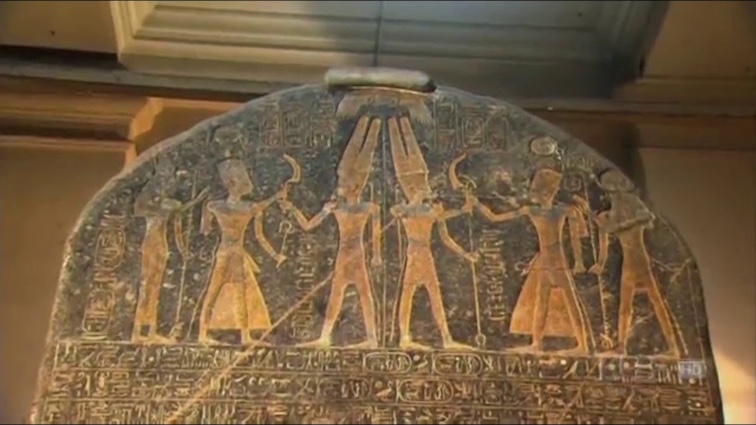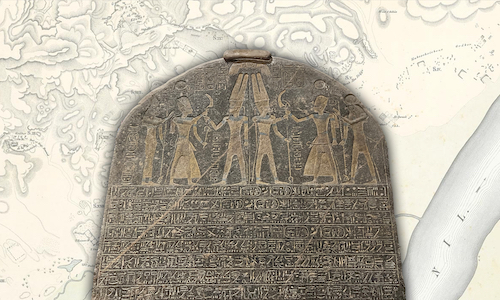Israelite Origins: Late Date Exodus
Just before we get into the historical background of the relevant time period for investigating Israelite origins in Canaan we have one side issue to deal with – the “Late Date” Exodus. The date of the Exodus is intimately connected to the emergence of the Israelites in Canaan when looking at the topic as a Christian because the Israelites, according to a selective and face-value reading of the narratives, arrived in Canaan forty years after they left Egypt. If that’s what happened then we’ve got our Israelite origins sorted, and we can stop this series right now.
The “Late Date” that we’re going to look at stands in contrast to the “Early Date” for the Exodus that we’ve covered before. To save you reading that previous post here’s a quick refresher on the Early Date…
The conservative Christian position on the date of the Exodus is that it took place in precisely 1446 BCE. Rather uncharitably but fairly accurately Dever describes those who hold to this position as “a handful of diehard fundamentalists”1, and here’s why: they arrive at this date by simply taking 1 Kings 6:1 at face value:
1 Ki 6:1 “In the four hundred eightieth year after the Israelites came out of the land of Egypt, in the fourth year of Solomon’s reign over Israel… he began to build the house of the LORD.”2
Given the traditional date for the beginning of Solomon’s reign of 970 BCE, 480 years before his 4th year is 1446 BCE (970 + 4 – 480); the “Early Date” Exodus. And that’s where Early Daters stop. Every other bit of evidence, textual or archaeological, is considered secondary and is made to fit that reading of that verse – if it’s considered at all.
However, as we’ve previously shown, this simple “solution” is flawed from a number of angles and can be dismissed as being as “biblical” a date for the Exodus as 1406 BCE (same passage, just in the LXX), 1539 BCE (chronology of Acts 13), and 1596 BCE (sum of the narrative time periods).
So, that’s the Early date. What’s this Late Date thing?
Well, it’s not so much a date as it is a time span. The Late Date position is that the Israelites left Egypt some time after 1270 BCE, and arrived in Canaan some time before approx 1210 BCE. How do Late Daters arrive at this conclusion?
Steles and store cities
Here’s the key biblical passage that informs the Late Date view:
Ex 1:11 Therefore they [the Egyptians] set taskmasters over them [the Israelites] to oppress them with forced labor. They built supply cities, Pithom and Rameses, for Pharaoh.
That’s a pretty useful data point. If the Israelites helped build Pithom and Rameses then they can’t have left Egypt before the construction of those cities began. So, when were Pithom and Rameses built? Well, at least for Pithom, it’s complicated…
Pithom
The name “Pithom”, from the Egyptian ‘Pr-itm’3, is universally understood to mean “House of Atum”4. That much is easy. The problem lies with its location: no one knows where it is. Various archaeologists have proposed various options, but there’s no consensus on the matter.
Three sites that have been suggested by various archaeologists over the past 150 years are:
- Tell el-Maskhuta
- Tell el-Ratabah
- Heliopolis
There are difficulties with each option5:
- Tell el-Maskhuta was not occupied after the Middle Kingdom until the Saite period in the late 7th century – i.e. it was uninhabited during the relevant periods dictated by both the Early and Late dates for the Exodus.
- Tell el-Ratabah was abandoned during the New Kingdom period until the 12th century – also uninhabited during the relevant periods for both Exodus dates.
- There’s no proof that the temple at Heliopolis was dedicated to Atum, so identifying Heliopolis with Pr-itm is pretty flakey.
This is as much as can be said with any confidence:
About the only existing consensus among scholars is that more archaeological evidence is needed to make a definite conclusion.6
Rameses
The location of this better known ancient city is less problematic. Rameses, or Pi-ramesse in Egyptian7, is located at Qantir. Though there had been a small amount of building taking place there before Rameses II, it was he who made the place a sprawling city and royal residence. Building proper began sometime after Rameses II came to power in in 1279 BCE; the city became a very large administrative centre, but was wholly abandoned in 1069 BCE8.
So, though Pithom doesn’t help with dating the Exodus, Pi-ramesse provides a fixed window for the beginning of the exodus – i.e. the Israelite wandering must have started after 1279 BCE and cannot have started any later than 1069 BCE; at least, if the Israelites were involved as slaves with Pi-ramesse’s construction as Ex 1:11 claims.
Merneptah Stele
At the other end there’s the Merneptah Stele.
After Ramses II passed off the scene he was succeeded by one of his many sons, Merneptah. Around a couple of years into his reign, also ruling from Pi-ramesse, sometime around 1208 BCE Pharaoh Merneptah went for a jolly jaunt up to the Levant to butcher some locals.9 The following text is from a Stele, today called the Merneptah Stele, or Israel Stele, erected to commemorate both this event as well as his victory over the Libyans a few years later. Close to the bottom of the stele we find this:
The princes are prostrate, saying: “Mercy!”
Not one raises his head among the Nine Bows.
Desolation is for Tehenu; Hatti is pacified;
Plundered is the Canaan with every evil;
Carried off is Ashkelon; seized upon is Gezer;
Yanoam is made as that which does not exist;
Israel is laid waste, his seed is not;
Hurru is become a widow for Egypt!
All lands together, they are pacified;
Everyone who was restless, he has been bound by the King of Upper and Lower Egypt: Ba-en-Re Meri-Amon; the Son of Re: Mer-ne-Ptah Hotep-hir-Maat, given life like Re every day.10
“Israel is laid waste.” That’s the key bit. We’ll get into the detail of the Merneptah Stele and what it can tell us in more detail later in this series; for now we’re just interested in it from the point of view of the Late Date Exodus.

The significance of the text to the topic of Israelite Origins should be obvious: If the Egyptians bumped into a people called “Israel” somewhere in Canaan, the Israelites must have already finished their wilderness wandering and arrived in Canaan, giving us the absolute latest date that the Israelites could have arrived in Canaan.
And that’s how the reasoning for the Late Date Exodus goes. The Israelites were used as slaves building Pi-ramesse – something which didn’t commence until sometime after 1279 BCE, and that they were in Canaan by around 1208 BCE because Pharaoh Merneptah bumped into them there. To give the Israelites time to be slaves, another 40 years to wander in the wilderness, and also to give them time to settle down in Canaan before Pharaoh Merneptah supposedly annihilated them a common date range given for the Exodus is 1265-1225 BCE.
Here’s how Ernest Wright summarises the argument in his well known book, Biblical Archaeology (you’ll notice some of the dates are slightly different; research has moved on since he wrote almost half a century ago):
The significance of this mention of Israel [on the Merneptah Stele]is that by 1220 B.C. a group which was to give its name to the nation was already in its later home, though not yet a settled nation. On the other hand, it was pointed out in the last chapter that if Israelites had anything to do with Egyptian royal work projects in the cities Pithom and Raamses (Ex 1:11), some of them must have been still in Egypt at least during the early years of Pharaoh Rameses II (1290-1224). Consequently, the most reasonable hypothesis is that the Exodus under Moses occurred sometime during the first half of the 13thcentury.11
Things to bear in mind
The Late Date Exodus position makes a number of assumptions:
- It assumes that Ex 1:11 is an accurate historical record
- That there was a recognisable people group in Egypt known as Israelites
- That they were slaves
- That they were used in the building of Pithom and Rameses
- It assumes that pretty much all the Israelites left Egypt in one go.
- It assumes that they wandered through the wilderness for approximately 40 years.
- It assumes that the “Israel” of the Merneptah Stele is the same group of people who left Egypt en-masse, not an indigenous Canaanite tribe.
i.e. it takes the Exodus narrative, largely as it’s taught in Sunday School, at face value. To point out these assumptions is not to dismiss the Late Date view; it’s just to acknowledge the fact that implicit in the position is a collection of assumptions which really ought to be verified. As we will see as the series continues, doing so is quite a tricky matter. Still, the Late Date position is a whole lot better than the Early Date, as we shall see. It at least tries to marry the text up to some archaeological evidence rather than being a face-value and faulty reading of a single and arbitrarily-selected verse from a book written at the earliest during the Babylonian Exile.12
So, we’ve reminded ourselves of the Sunday School version of where the Israelite came from, we’ve surveyed the archaeological evidence which casts great doubt over that easy narrative, and we’ve looked into some of the Biblical counter-narratives that demonstrate that the Sunday School version of Israelite origins is so oversimplified as to be unhelpful when investigating the origins of the Israelites.
It was necessary that the word of God should first have been turned to: but seeing that a flat, face-value reading gave us conflicting narratives about Israelite origins, and appears to judge the topic to be of little historical import, lo, we turn to the archaeologists. (Not Acts 13:46 KJV)
In the next post we’ll survey what the relevant scholars have to say about when in history we should look for Israelite origins, and then get into the historical background of that period.
Footnotes
-
William G. Dever, Who Were the Early Israelites and Where Did They Come From? (Grand Rapids, MI; Cambridge, U.K.: William B. Eerdmans Publishing Company, 2006), 8. ↩
-
Unless otherwise noted all scripture quotes are from the New Revised Standard Version (Nashville: Thomas Nelson Publishers, 1989). ↩
-
Ronald B. Redford, Egypt, Canaan, and Israel in Ancient Times (Princeton University Press, 1992), 451. ↩
-
Ludwig Koehler et al., The Hebrew and Aramaic Lexicon of the Old Testament (Leiden: E.J. Brill, 1994–2000), 990. ↩
-
William G. Dever, Who Were the Early Israelites and Where Did They Come From? (Grand Rapids, MI; Cambridge, U.K.: William B. Eerdmans Publishing Company, 2006), 13–14. ↩
-
Tom F. Wei, “Pithom (Place),” ed. David Noel Freedman, The Anchor Yale Bible Dictionary (New York: Doubleday, 1992), 377. ↩
-
Ludwig Koehler et al., The Hebrew and Aramaic Lexicon of the Old Testament (Leiden: E.J. Brill, 1994–2000), 1268. ↩
-
″Before the Twentieth Dynasty ended (ca. 1069 B.C.), the city had been abandoned, and the remaining Ramesside kings moved to Memphis. The city became a ghost town because the Pelusiac branch of the Nile that passed by the city had migrated so far away that the city had been cut off from its transportation artery.” James Hoffmeier, Ancient Israel in Sinai (Oxford University Press, 2005), 57. ↩
-
William W. Hallo and K. Lawson Younger, Context of Scripture (Leiden; Boston: Brill, 2000), 41. ↩
-
James Bennett Pritchard, ed., The Ancient Near Eastern Texts Relating to the Old Testament (3rd ed. with Supplement.; Princeton: Princeton University Press, 1969), 378. ↩
-
G. Ernest Wright, Biblical Archaeology (Redwood Burn, 1974), 70-71. ↩
-
Maybe I should say what I really think about the Early Date? ↩




